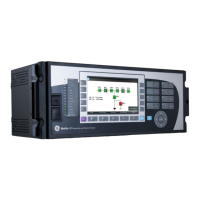9-10 D60 Line Distance Protection System GE Multilin
9.3 PROTECTION SIGNALING SCHEMES 9 APPLICATION OF SETTINGS
9
c) LOSS-OF-GUARD OPERATION
The loss-of-guard operation picks under the following conditions:
• The scheme is enabled (
DCUB FUNCTION is “Enabled” and DCUB BLOCK is “Off”), and
• any loss-of-guard signal is received without its associated RX signal, and
• a fault is seen in the forward zone 2 distance elements or ground directional forward function (if configured), and
• the reverse zone 4 distance elements or ground directional reverse function (if configured) did not pickup to set the
transient blocking.
If these conditions are met, then the
DCUB LOG PICKUP DELAY timer is started. After this timer times out, the trip table is run,
operating the scheme and asserting the
DCUB OP FlexLogic operand. The trip table with the aid of the local phase selector
and loss-of-guard signals will determine what tripping operands will be operated. The DCUB LOG PICKUP DELAY timer allows
for any and all channel(s) to transition from guard to permissive before operating due to loss-of-guard in the presence of a
forward fault. The time window of allowing the scheme to operate when no
DCUB RX signal is received when any loss-of-
guard was received is the difference between the DCUB LOG TRIP WINDOW and DCUB LOG PICKUP DELAY timers. When using
default settings, this value is 150 – 8 = 142ms. This means the scheme is unblocked and can trip during this time window if
a forward fault is sensed.
d) KEYING OF THE CARRIER(S) UNDER NORMAL CONDITIONS
The keying signals, which allows the relay to key the permissive channel during normal permissive scheme operation by
means of the
DCUB TX1 through DCUB TX4 signals, are established as follows:
• The scheme is enabled (DCUB FUNCTION is “Enabled” and DCUB BLOCK is “Off”), and
• a fault is seen in the forward zone 2 distance elements or ground directional forward function (if configured), and
• the reverse zone 4 distance elements or ground directional reverse function (if configured) did not pickup to set the
transient blocking.
If these conditions are met, then the scheme will key the channel(s) by means of asserting transmit signals
DCUB TX1
through DCUB TX4 with the aid of the local phase selector or zone 2 distance elements.
e) KEYING OF THE CARRIER DURING ECHO CONDITIONS
The echo signal, which allows the relay to key the permissive channel(s) through the DCUB TX1 through DCUB TX4 transmit
operands during echo conditions when the local breaker opened, will key the carrier(s) during the following conditions:
• The scheme is enabled (DCUB FUNCTION is “Enabled” and DCUB BLOCK is “Off”), and
•the DCUB PERMISSIVE ECHO setting is “Enabled”, and
•the
LINE PICKUP LEO PKP operand that detects the local breaker to be open picks up for a time set by LINE END OPEN
PICKUP DELAY
, and
• any permissive signal
DCUB RX1 through DCUB RX4 is received and any LOG1 to LOG4 is received, and
• a fault is not seen in the forward zone 2 distance elements or ground directional forward function (if configured) for at
least 100 ms, and
• the reverse zone 4 distance elements or ground directional reverse function (if configured) did not pickup to set the
transient blocking.
If these conditions are met, then the scheme will echo (transmit the
DCUB TX1 through DCUB TX4 operands) the received
permissive
DCUB RX signal(s) back to the remote relay based on the echo table.
The keying or transmit signals
DCUB TX1 through DCUB TX4 consist of all normal keying or echo keying conditions.
The scheme
DCUB TRIP A, DCUB TRIB B, DCUB TRIP C, and DCUB TRIP 3P output operands are hard-wired to the trip output
scheme. As such, if the trip output or breaker control operands (if the breaker control function is used) are used for tripping,
the scheme fully operational. The permissive key carrier signals
DCUB TX1 through DCUB TX4 must still be assigned to the
tripping/operating logic, and to output contacts as per the usual D60 logic/output assignments.

